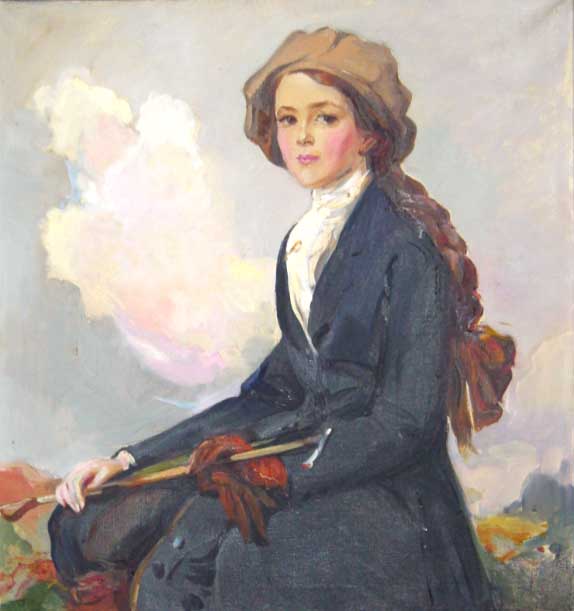Burchfield
Penney Art
Center - Table of Content
Levy,
WWI Posters
Alexander O. Levy Exhibit Paintings
Burchfield Penney
Art Center
at Buffalo State College
1300 Elmwood Avenue, Buffalo, NY
Burchfield
Penney Art Center
- Official Home Page
Exhibit: Friday, November 14, 2014–Sunday, March 29, 2015
 "Rumba Dancer" ... Art Deco style ... "By far the most alluring paintings are Levy’s portraits, commissioned and otherwise, few more so than “The Rumba Dancer” from 1934, which depicts a dancer in a flowing, multicolored dress giving a sideways glance at someone just outside of the frame as a band plays music behind her." - Colin Dabkowski Two details below:   |
 Untitled ("The Beach") Two details below:   |
  |
  Lady in White, undated; oil on canvas (possibly an advertising piece), 30 x 26 inches One detail below:  |
 Untitled Three details below:    |
  24 x 28 inches Two details below:   |
 Untitled 3-panel folding screen, c. 1925 Recto: Flying red flamingos, Pan watching 4 nude females, fantasy landscape, metallic gold sky; Verso: southwestern tra; oil on canvas, double-sided, 60 x 66 inches |
  |
   |
 Mary Frances Larkin Kellogg, the only daughter of John D. Larkin Jr. and Edna Crate Larkin. Photo courtesy of Brian Kellogg |
  |
|
At the turn of the century Buffalo, New York now served as a home-base to an impressive number of professional American artists. Among them were Claire Shuttleworth, Mildred Green, Evelyn Rumsey Lord, Charles Reiffel, Raphael Beck, and the East Aurora Barbizon painter, Alexis Fournier. 1909 brought the arrival of one of the most interesting artists; the painter and illustrator Alexander O. Levy. Levy, like others, came to work commercially and by 1913 was established as the art director of the Larkin Company. During the 1920s he arguably rose to be Buffalo's best known artist with an international reputation, exceeding the reputation of Charles E. Burchfield, who had just arrived in 1921 to design wallpaper in Buffalo at the M.H. Birge & Sons Co. Born in Bonn, Germany, Levy grew up in Cincinnati in the 1880s. He was a child prodigy; at age eight he won a city-wide art prize awarded by the local newspapers; at twelve, he turned down a scholarship to study the violin in Europe. In his teens, Levy studied at the Cincinnati School of Music and the Cincinnati Art School under the artist Frank Duveneck. Most of Levy's canvases, the large major ones, were completed within a day or, only a few hours. By the 1920s, Levy was on his way to earning attention and national recognition as a creative artist. However, a strong individualist, he belonged to no school of artists and his work had a unique quality different from any of his contemporaries. He developed an Art Deco style into the composition of his paintings. Although set in a field of an almost nouveau dreamy space, his figures are strong and separate. In these paintings, he uses color for its decorative value rather than to recreate reality. The Great Depression hurt most American artists, and the market for regional art all but evaporated, and Levy’s work in national and international exhibitions almost halted by the late 1930’s. Under the impact of the economic crisis, Levy changed his style. His work became more realistic, his brushstrokes tighter and his focus switched from fantasies to a concern with social problems. |
|
Excerpts
from
Alexander O. Levy’s Buffalo Paintings Depict a Great City on the Rise By Colin Dabkowski The Buffalo News December 16, 2014 For a booming city at the height of its power and influence, Alexander O. Levy was the right artist at the right time. When the German-born artist arrived here from New York City in 1909 to work as an illustrator for the Matthews-Northrup publishing company, the city’s population stood at more than 400,000. By the time he died, in 1947, it had swelled past 500,000 and was perched at the edge of its painful and ongoing decline. The interceding four decades were filled with radical change, as the city built out its infrastructure, welcomed new residents from across the world and worked overtime to maintain its status as a reigning industrial powerhouse. So it’s lucky for us that Levy arrived when he did, and luckier still that he painted so prolifically. The lucky streak continues in the Burchfield Penney Art Center’s exhibition “Alexander O. Levy: American Artist, Art Deco Painter,” a ravishing and often intoxicating chronicle of a grand city in the midst of a seemingly inexorable journey toward further grandeur. By far the most alluring paintings are Levy’s portraits, commissioned and otherwise, few more so than “The Rumba Dancer” from 1934, which depicts a dancer in a flowing, multicolored dress giving a sideways glance at someone just outside of the frame as a band plays music behind her. The exhibition’s handsome and indispensable catalog spends a lot of ink pondering the ways in which Levy’s work fits or deviates from the murky “Art Deco” label, a category normally associated with architecture such as Buffalo’s City Hall or the Chrysler Building in New York City. Those interested in erudite speculation about what makes Levy’s painting Art Deco or not would do well to read about it there, but I think the label we slap on his work is less relevant than the stories it tells us about its time and place. |
On
Buffalo Architecture and
History website:
|
Photos and their arrangement © 2015 Chuck LaChiusa
| ...Home Page ...| ..Buffalo Architecture Index...| ..Buffalo History Index... .|....E-Mail ...| ..

web site consulting by ingenious, inc.